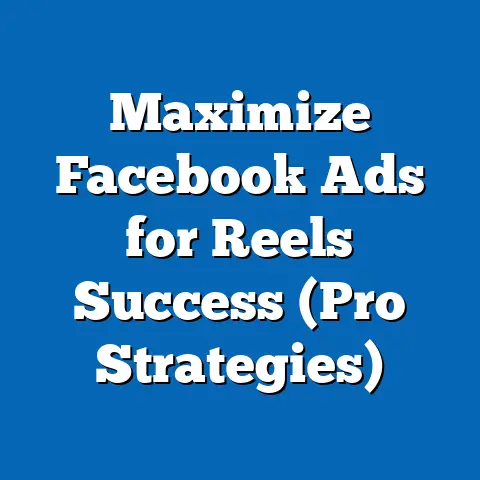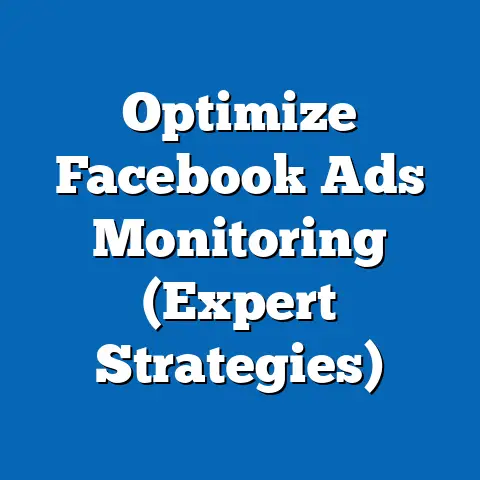Boost Conversions with Remarketing Facebook Ads (Strategic Insights)
The digital advertising landscape is a constantly shifting terrain, and staying ahead of the curve is crucial for any business looking to thrive. Among the myriad of platforms available, Facebook Ads stands as a titan, boasting billions of active users and a sophisticated advertising infrastructure. But simply throwing ads at a massive audience isn’t enough. Today, it’s about precision, relevance, and personalization. That’s where remarketing comes in.
Remarketing, in essence, is the art of re-engaging those who have already shown interest in your brand. Think of it as a second chance to make a first impression, or a gentle nudge to guide potential customers further down the sales funnel. It’s not about bombarding everyone with the same message; it’s about crafting targeted ads that speak directly to the needs and interests of specific user segments.
We’re living in an era where consumers are bombarded with information. Generic advertising often gets lost in the noise. People crave experiences that feel tailored to them, and they’re more likely to convert when they feel understood. This is where remarketing shines. By leveraging data-driven approaches, we can create highly personalized ads that resonate with potential customers, ultimately leading to higher conversion rates.
I remember when I first started experimenting with Facebook Ads, I was so focused on reaching as many people as possible. I thought, “The more eyeballs, the better!” But my conversion rates were abysmal. It wasn’t until I delved into the power of remarketing that I started seeing real results. I realized that focusing on those who had already visited my website or interacted with my content was far more effective than casting a wide net.
Section 1: Understanding Remarketing
So, what exactly is remarketing? It’s more than just showing ads to people who have visited your website. It’s a strategic approach to nurturing potential customers by reminding them of your brand and the value you offer. It’s about delivering the right message, to the right person, at the right time.
Defining Remarketing
Remarketing, also known as retargeting, is a form of online advertising that allows you to show ads to people who have previously interacted with your website, mobile app, or social media profiles. Unlike traditional advertising, which often targets a broad audience based on demographics and interests, remarketing focuses on individuals who have already expressed some level of interest in your products or services.
Think of it like this: imagine you’re browsing an online store, looking at a specific pair of shoes. You don’t buy them right away, but you add them to your cart. A few days later, you start seeing ads for those exact shoes on Facebook. That’s remarketing in action. It’s a subtle reminder that helps bring you back to complete the purchase.
How Facebook’s Remarketing Capabilities Work
Facebook’s remarketing capabilities are incredibly powerful, thanks to its vast user base and sophisticated targeting options. Here’s a breakdown of the key components:
- Facebook Pixel: This is a small snippet of code that you place on your website. It tracks visitor behavior, such as page views, product views, and purchases. This data is then used to create custom audiences for remarketing.
- Custom Audiences: These are audiences you create based on specific criteria, such as website visitors, app users, or customers on your email list. You can upload your existing customer data to Facebook and match it with user profiles to create highly targeted audiences.
- Dynamic Ads: These are personalized ads that automatically show products or services that people have previously viewed on your website. They’re particularly effective for e-commerce businesses looking to re-engage potential customers with the items they were considering.
I remember setting up the Facebook Pixel for the first time. It seemed a bit daunting, but the step-by-step instructions made it manageable. And the results were well worth the effort. Suddenly, I was able to show ads to people who had abandoned their shopping carts, resulting in a significant boost in sales.
The Evolution of Remarketing Strategies
Remarketing has come a long way since its early days. Initially, it was a fairly basic process of showing ads to anyone who had visited a website. However, as technology has advanced and consumer expectations have evolved, remarketing strategies have become much more sophisticated.
- Early Days: Simple retargeting based on website visits.
- Mid-Stage: Introduction of custom audiences and more granular targeting options.
- Present Day: Highly personalized dynamic ads, advanced audience segmentation, and cross-platform remarketing.
The key driver of this evolution has been data. As we’ve gained access to more information about consumer behavior, we’ve been able to create more targeted and effective remarketing campaigns.
The Importance of Remarketing in the Customer Journey
Remarketing plays a crucial role in the customer journey, particularly in the consideration and decision stages. It helps to:
- Re-engage potential customers: Remind them of your brand and the value you offer.
- Nurture leads: Provide them with additional information and incentives to move further down the sales funnel.
- Recover lost sales: Target those who abandoned their shopping carts or didn’t complete a purchase.
- Increase brand awareness: Keep your brand top-of-mind for potential customers.
I’ve seen firsthand how remarketing can transform a lukewarm lead into a loyal customer. By providing targeted ads that address their specific needs and concerns, you can build trust and encourage them to take the next step.
Key Takeaway: Remarketing is a powerful tool for re-engaging potential customers and driving conversions. By understanding how it works and leveraging Facebook’s capabilities, you can create highly effective campaigns that deliver real results.
Next Steps: Make sure you have the Facebook Pixel installed on your website and start experimenting with custom audiences to see how you can re-engage your website visitors.
Section 2: Current Trends in Remarketing on Facebook
The world of digital marketing is constantly evolving, and remarketing on Facebook is no exception. To stay ahead of the game, it’s crucial to be aware of the latest trends and adapt your strategies accordingly.
Increasing Use of Video Ads for Remarketing
Video is king, and that’s especially true when it comes to remarketing. Video ads are more engaging than static images and text, allowing you to tell a more compelling story and capture the attention of potential customers.
I’ve found that video ads are particularly effective for showcasing product demos, customer testimonials, or behind-the-scenes glimpses of your business. They can also be used to address common objections or answer frequently asked questions.
Growth of Personalization in Ad Experiences
Generic advertising is becoming increasingly ineffective. Consumers expect personalized experiences that are tailored to their individual needs and interests. That means your remarketing ads should be highly relevant to the specific user you’re targeting.
For example, if someone has viewed a particular product on your website, your remarketing ad should showcase that exact product, along with relevant information and incentives. You can also personalize your ads based on demographics, interests, and past purchase behavior.
The Rise of Mobile-First Strategies in Remarketing Campaigns
With the majority of Facebook users accessing the platform on their mobile devices, it’s essential to adopt a mobile-first approach to your remarketing campaigns. That means optimizing your ads for mobile viewing, using mobile-friendly landing pages, and ensuring that your call-to-actions are easy to tap on a touchscreen.
I always make sure to preview my ads on a mobile device before launching a campaign. It’s amazing how different an ad can look on a small screen compared to a desktop monitor.
Consumer Privacy Concerns and Data Protection Regulations
Consumer privacy is a growing concern, and data protection regulations like GDPR and CCPA are forcing marketers to be more transparent and responsible with their data collection and usage practices.
This means you need to be upfront about how you’re using the Facebook Pixel and how you’re collecting and using user data. You also need to provide users with the option to opt out of remarketing if they choose.
I’ve added a privacy policy to my website that clearly explains how I use the Facebook Pixel and how users can opt out of remarketing. It’s a simple step that can go a long way in building trust with your audience.
Case Studies of Successful Brands
Let’s take a look at some real-world examples of brands that are successfully leveraging these trends to boost conversions with Facebook remarketing:
- Example 1: E-commerce Brand Using Dynamic Video Ads. An online clothing retailer uses dynamic video ads to remarket to users who viewed specific items on their website. The video ads showcase the product in action, highlighting its features and benefits. They also include a clear call-to-action to “Shop Now.” This strategy resulted in a 30% increase in conversion rates.
- Example 2: Software Company Using Personalized Ads. A software company uses personalized ads to target users who downloaded a free trial. The ads highlight the key benefits of the paid version of the software and offer a limited-time discount. This strategy resulted in a 20% increase in trial-to-paid conversions.
These examples demonstrate the power of video ads and personalization in driving conversions with Facebook remarketing.
Key Takeaway: Staying up-to-date with the latest trends in remarketing on Facebook is essential for maximizing your ROI. Embrace video ads, personalization, mobile-first strategies, and be mindful of consumer privacy concerns.
Next Steps: Audit your current remarketing campaigns and identify areas where you can incorporate these trends to improve performance.
Section 3: Crafting Effective Remarketing Campaigns
Now that we’ve covered the fundamentals and current trends, let’s dive into the nitty-gritty of crafting effective remarketing campaigns on Facebook. This is where the rubber meets the road, and where you can truly unlock the power of this advertising technique.
Key Components of a Successful Remarketing Campaign
A successful remarketing campaign on Facebook is built on several key components:
- Clear Goals: What do you want to achieve with your campaign? Increase sales? Generate leads? Drive traffic to your website? Defining your goals upfront will help you measure your success and optimize your campaign accordingly.
- Targeted Audience: Who are you trying to reach with your ads? The more targeted your audience, the more relevant your ads will be, and the higher your conversion rates will be.
- Compelling Ad Creative: Your ad creative needs to grab attention and communicate your message effectively. Use high-quality images or videos, write compelling copy, and include a clear call-to-action.
- Optimized Landing Page: Your landing page should be relevant to your ad and provide a seamless user experience. Make it easy for visitors to take the desired action, whether it’s making a purchase, filling out a form, or downloading a resource.
- Tracking and Analytics: You need to track your campaign performance and analyze the data to identify areas for improvement. Use Facebook Insights and Google Analytics to monitor your key metrics and make data-driven decisions.
Audience Segmentation and Targeting Strategies
Audience segmentation is the process of dividing your audience into smaller groups based on specific characteristics, such as demographics, interests, and behavior. This allows you to create more targeted ads that are relevant to each segment.
Here are some common audience segmentation strategies:
- Website Visitors: Target people who have visited specific pages on your website.
- App Users: Target people who have used your mobile app.
- Email Subscribers: Target people on your email list.
- Customers: Target people who have purchased from you in the past.
- Lookalike Audiences: Target people who share similar characteristics to your existing customers.
Creating lookalike audiences is one of my favorite Facebook Ads features. It allows you to tap into a pool of potential customers who are likely to be interested in your products or services. Facebook uses its vast data to identify users who share similar demographics, interests, and behaviors to your existing customers, and then targets them with your ads.
Ad Creative and Message Tailoring
Your ad creative is the visual and textual elements of your ad. It needs to be eye-catching, informative, and relevant to your target audience. Here are some tips for creating compelling ad creative:
- Use high-quality images or videos: Visuals are the first thing people see, so make sure they’re professional and engaging.
- Write compelling copy: Your copy should be clear, concise, and persuasive. Highlight the benefits of your product or service and include a strong call-to-action.
- Tailor your message to your audience: Speak directly to the needs and interests of your target audience. Use language that resonates with them and address their specific pain points.
- Test different ad variations: Experiment with different headlines, images, and copy to see what performs best.
I’ve found that using customer testimonials in my ad creative is a great way to build trust and credibility. Seeing real people rave about your product or service can be incredibly persuasive.
Setting Up Remarketing Ads in Facebook Ads Manager
The Facebook Ads Manager is your central hub for creating and managing your remarketing campaigns. Here’s a step-by-step guide to setting up remarketing ads:
- Create a new campaign: Choose your campaign objective (e.g., conversions, traffic, lead generation).
- Define your audience: Select your custom audience or create a new one based on website visitors, app users, or other criteria.
- Set your budget and schedule: Determine how much you want to spend on your campaign and how long you want it to run.
- Choose your ad placements: Select where you want your ads to appear (e.g., Facebook News Feed, Instagram Feed, Audience Network).
- Create your ad: Choose your ad format (e.g., image, video, carousel), upload your creative, and write your copy.
- Track your results: Monitor your campaign performance and make adjustments as needed.
Customizing Ad Placements for Optimal Visibility
Ad placements refer to where your ads appear on Facebook and its partner networks. You can choose to have your ads appear in the Facebook News Feed, Instagram Feed, Audience Network, and other placements.
It’s important to customize your ad placements based on your target audience and your campaign goals. For example, if you’re targeting mobile users, you’ll want to focus on mobile-friendly placements like the Facebook and Instagram Feeds.
Implementing A/B Testing to Refine Ad Performance
A/B testing, also known as split testing, is the process of comparing two versions of your ad to see which one performs better. You can A/B test different headlines, images, copy, and call-to-actions.
A/B testing is a crucial part of optimizing your remarketing campaigns. It allows you to identify what resonates with your audience and make data-driven decisions to improve your ad performance.
I use A/B testing extensively in my Facebook Ads campaigns. I’ll often run multiple versions of the same ad with slight variations to see which one generates the highest click-through rate and conversion rate.
Successful Campaign Examples with Metrics
Here are a few more examples of successful remarketing campaigns with metrics:
- Example 1: Lead Generation Campaign. A real estate agent ran a remarketing campaign targeting people who had visited their website and viewed property listings. The ads offered a free home valuation and a consultation. The campaign resulted in a 40% increase in leads and a 25% increase in sales.
- Example 2: E-commerce Campaign. An online jewelry retailer ran a remarketing campaign targeting people who had abandoned their shopping carts. The ads offered a 10% discount and free shipping. The campaign resulted in a 20% increase in recovered sales and a 15% increase in average order value.
These examples demonstrate the potential of remarketing to drive significant results for businesses of all sizes.
Key Takeaway: Crafting effective remarketing campaigns on Facebook requires a strategic approach, including clear goals, targeted audiences, compelling ad creative, optimized landing pages, and ongoing tracking and analysis.
Next Steps: Start planning your next remarketing campaign by defining your goals, identifying your target audience, and crafting compelling ad creative.
Section 4: Measuring Success and Optimizing Campaigns
Creating a remarketing campaign is only half the battle. The other half is measuring its success and optimizing it for maximum performance. Data is your best friend in this process. By tracking the right metrics and analyzing the data, you can identify what’s working and what’s not, and make adjustments accordingly.
Key Performance Indicators (KPIs) Relevant to Remarketing Campaigns
Here are some key performance indicators (KPIs) that you should be tracking for your remarketing campaigns on Facebook:
- Click-Through Rate (CTR): The percentage of people who click on your ad after seeing it. A high CTR indicates that your ad creative and targeting are effective.
- Conversion Rate: The percentage of people who take the desired action after clicking on your ad (e.g., making a purchase, filling out a form). A high conversion rate indicates that your landing page and offer are compelling.
- Cost Per Acquisition (CPA): The cost of acquiring a new customer through your remarketing campaign. A low CPA indicates that your campaign is efficient and cost-effective.
- Return on Ad Spend (ROAS): The amount of revenue you generate for every dollar you spend on your remarketing campaign. A high ROAS indicates that your campaign is profitable.
- Website Traffic: The amount of traffic your remarketing campaign is driving to your website. Increased website traffic can lead to increased brand awareness and potential conversions.
Tracking and Analyzing Data Using Facebook Insights and Google Analytics
Facebook Insights and Google Analytics are two powerful tools for tracking and analyzing your remarketing campaign data.
- Facebook Insights: Provides data on your ad performance, including impressions, reach, clicks, and conversions. You can also use Facebook Insights to learn more about your audience, such as their demographics, interests, and behavior.
- Google Analytics: Provides data on your website traffic, including sources, landing pages, and user behavior. You can use Google Analytics to track the performance of your remarketing campaigns and see how they’re contributing to your overall website traffic and conversions.
I spend a significant amount of time analyzing data in Facebook Insights and Google Analytics. It’s like being a detective, piecing together clues to understand what’s working and what’s not.
Strategies for Interpreting Data to Identify Trends and Areas for Improvement
Interpreting data can be challenging, but it’s essential for optimizing your remarketing campaigns. Here are some strategies for identifying trends and areas for improvement:
- Look for patterns: Are certain ad creative formats performing better than others? Are certain audience segments more likely to convert?
- Compare different time periods: How is your campaign performing compared to last week, last month, or last year?
- Segment your data: Analyze your data by audience segment, ad placement, and other factors to identify areas where you can improve targeting and messaging.
- Use A/B testing to validate your hypotheses: If you have a theory about why a certain ad creative is performing better than another, use A/B testing to validate your hypothesis.
The Importance of Ongoing Optimization and Iteration
Optimization is an ongoing process, not a one-time event. You should be constantly monitoring your campaign performance, analyzing the data, and making adjustments to improve your results.
Here are some common optimization tactics:
- Refine your targeting: Experiment with different audience segments and targeting options to find the most responsive audiences.
- Improve your ad creative: Test different headlines, images, and copy to see what performs best.
- Optimize your landing page: Make sure your landing page is relevant to your ad and provides a seamless user experience.
- Adjust your budget and schedule: Allocate more budget to your best-performing ads and adjust your schedule to reach your audience when they’re most likely to convert.
Key Takeaway: Measuring success and optimizing your remarketing campaigns is an ongoing process that requires careful tracking, analysis, and iteration. Use Facebook Insights and Google Analytics to monitor your key metrics and make data-driven decisions to improve your results.
Next Steps: Set up tracking in Facebook Insights and Google Analytics, and start monitoring your key metrics. Identify areas where you can improve your campaign performance and implement optimization tactics accordingly.
Section 5: Future of Remarketing on Facebook
The future of remarketing on Facebook is bright, with new technologies and trends emerging all the time. As artificial intelligence and machine learning continue to advance, remarketing campaigns will become even more personalized and effective.
Emerging Technologies and Their Impact
- Artificial Intelligence (AI): AI can be used to automate many aspects of remarketing, such as audience segmentation, ad creative optimization, and bidding strategies. AI can also be used to personalize ad experiences in real-time based on user behavior.
- Machine Learning (ML): ML can be used to identify patterns in your data and predict which users are most likely to convert. This allows you to target your ads more effectively and improve your conversion rates.
- Augmented Reality (AR): AR can be used to create immersive and engaging ad experiences. For example, a furniture retailer could use AR to allow users to visualize how a piece of furniture would look in their home before making a purchase.
Potential Shifts in Consumer Behavior and Privacy Regulations
Consumer behavior is constantly evolving, and privacy regulations are becoming more stringent. This means that marketers need to be more mindful of how they collect and use user data.
- Increased Demand for Transparency: Consumers are demanding more transparency from brands about how their data is being collected and used.
- Growing Importance of Privacy: Consumers are becoming more concerned about their privacy and are more likely to opt out of remarketing if they feel their data is being misused.
- Stricter Regulations: Data privacy regulations like GDPR and CCPA are forcing marketers to be more responsible with their data collection and usage practices.
Social Commerce and Its Integration with Remarketing Efforts
Social commerce is the practice of selling products and services directly through social media platforms. Facebook is investing heavily in social commerce, making it easier for businesses to sell products directly to consumers through the platform.
Integrating social commerce with your remarketing efforts can be a powerful way to drive sales. For example, you can use remarketing ads to target people who have viewed products on your website and then offer them the opportunity to purchase those products directly through Facebook.
I’m excited about the potential of social commerce to transform the way we market and sell products. It’s a natural evolution of social media and a powerful way to connect with customers and drive sales.
Key Takeaway: The future of remarketing on Facebook is bright, with new technologies and trends emerging all the time. Embrace AI, ML, AR, and social commerce, and be mindful of consumer behavior and privacy regulations.
Next Steps: Stay informed about the latest developments in remarketing on Facebook and experiment with new technologies and strategies to improve your results.
Conclusion
Remarketing Facebook ads are a powerful tool for boosting conversions in today’s ever-evolving digital landscape. By understanding the fundamentals, staying up-to-date with current trends, crafting effective campaigns, and measuring your success, you can unlock the full potential of this advertising technique.
We’ve covered a lot of ground in this article, from defining remarketing to exploring the future of this dynamic field. The key takeaways are:
- Remarketing is essential for re-engaging potential customers and driving conversions.
- Staying up-to-date with the latest trends is crucial for maximizing your ROI.
- Crafting effective campaigns requires a strategic approach and careful attention to detail.
- Measuring success and optimizing your campaigns is an ongoing process.
- The future of remarketing is bright, with new technologies and trends emerging all the time.
I encourage you to take the insights and strategies discussed in this article and apply them to your own Facebook Ads campaigns. Experiment, test, and iterate, and you’ll be well on your way to achieving remarkable results.
The digital landscape is constantly changing, so it’s important to stay informed about the latest trends and adapt your strategies accordingly. Keep learning, keep experimenting, and keep pushing the boundaries of what’s possible with remarketing on Facebook. Your conversion rates will thank you for it.






